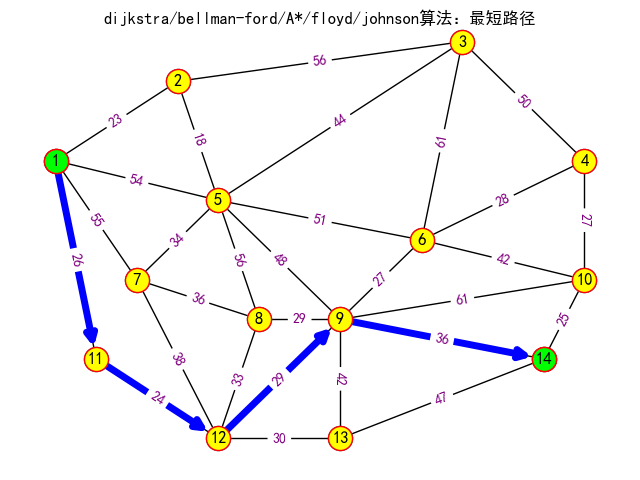Networkx库的学习历程:绘制最短路径
7 min read
Page Views
1.原始数据
各地点之间的距离数据如下所示:
1 2 3 4 5 6 7 8 9 10 11 12 13 14
1 23 54 55 26
2 23 56 18
3 56 50 44 61
4 50 28 27
5 54 18 44 51 34 56 48
6 61 28 51 27 42
7 55 34 36 38
8 56 36 29 33
9 48 27 29 61 29 42 36
10 27 42 61 25
11 26 24
12 38 33 29 24 30
13 42 30 47
14 36 25 47
2.python程序
import numpy as np
import pandas as pd
from scipy.sparse import coo_matrix
import networkx as nx
import matplotlib.pyplot as plt
"""
numpy: 1.24.3
pandas: 1.5.3
networkx: 3.1
matplotlib: 3.7.5
"""
# 避免图片无法显示中文
plt.rcParams['font.sans-serif'] = ['SimHei']
# 显示所有列
pd.set_option('display.max_columns', None)
pd.set_option('display.width', 1000)
# 读取数据
dataframe = pd.read_excel(io='data.xlsx', sheet_name='Sheet1', index_col=0)
dataframe = dataframe.fillna(0)
print('矩阵的空值以0填充:\n', dataframe)
coo = coo_matrix(np.array(dataframe))
# 矩阵行列的索引默认从0开始改成从1开始
coo.row += 1
coo.col += 1
data = [int(i) for i in coo.data]
coo_tuple = list(zip(coo.row, coo.col, data))
coo_list = []
for i in coo_tuple:
coo_list.append(list(i))
# 出发点
start_node = 1
# 目的地
target_node = 14
# 设置各顶点坐标(只是方便绘图,并不是实际位置)
pos = {1: (1, 8), 2: (4, 10), 3: (11, 11), 4: (14, 8), 5: (5, 7), 6: (10, 6), 7: (3, 5), 8: (6, 4), 9: (8, 4),
10: (14, 5), 11: (2, 3), 12: (5, 1), 13: (8, 1), 14: (13, 3)}
# 创建空的无向图
G = nx.Graph()
# 给无向图的边赋予权值
G.add_weighted_edges_from(coo_list)
# 单源最短路径dijkstra迪杰斯特拉算法求最短路径和最短路程
min_path_dijkstra = nx.dijkstra_path(G, source=start_node, target=target_node)
min_path_length_dijkstra = nx.dijkstra_path_length(G, source=start_node, target=target_node)
print('\ndijkstra算法:顶点%d到顶点%d的最短路径:%s,最短路程:%d' % (
start_node, target_node, min_path_dijkstra, min_path_length_dijkstra))
# 单源最短路径bellman-ford贝尔曼-福特算法求最短路径和最短路程
min_path_bellman_ford = nx.bellman_ford_path(G, source=start_node, target=target_node)
min_path_length_bellman_ford = nx.bellman_ford_path_length(G, source=start_node, target=target_node)
print('\nbellman-ford算法:顶点%d到顶点%d的最短路径:%s,最短路程:%d' % (
start_node, target_node, min_path_bellman_ford, min_path_length_bellman_ford))
# 单源最短路径A*算法求最短路径和最短路程
min_path_astar = nx.astar_path(G, source=start_node, target=target_node)
min_path_length_astar = nx.astar_path_length(G, source=start_node, target=target_node)
print('\nA*算法:顶点%d到顶点%d的最短路径:%s,最短路程:%d' % (
start_node, target_node, min_path_astar, min_path_length_astar))
# 多源最短路径floyd弗洛伊德算法求最短路径和最短路程
min_path_floyd, _ = nx.floyd_warshall_predecessor_and_distance(G)
min_path_length_floyd = nx.floyd_warshall_numpy(G)
min_path_length_floyd = pd.DataFrame(data=min_path_length_floyd, index=dataframe.index, columns=dataframe.columns)
print('\nfloyd算法:顶点%d到顶点%d的最短路径:%s,最短路程:%d' % (
start_node, target_node, nx.reconstruct_path(start_node, target_node, min_path_floyd),
min_path_length_floyd[start_node][target_node]))
# 多源最短路径johnson约翰逊算法求最短路径和最短路程
min_path_johnson = nx.johnson(G)
print('\njohnson算法:顶点%d到顶点%d的最短路径:%s' % (
start_node, target_node, min_path_johnson[start_node][target_node])) # networkx库没有专门针对johnson算法求最短路程的模块
plt.figure()
plt.suptitle('dijkstra/bellman-ford/A*/floyd/johnson算法:最短路径')
# 绘制无向加权图
nx.draw(G, pos, with_labels=True)
# 设置顶点颜色
nx.draw_networkx_nodes(G, pos, nodelist=G.nodes, node_color='yellow', edgecolors='red')
# 设置最短路径的边颜色、宽度、箭头效果
nx.draw_networkx_edges(G, pos, edgelist=[[min_path_dijkstra[i], min_path_dijkstra[i + 1]] for i in
range(len(min_path_dijkstra) - 1)], edge_color='blue', width=5, arrows=True,
arrowstyle='->', arrowsize=15)
# 显示无向加权图的边的权值
labels = nx.get_edge_attributes(G, 'weight')
# 显示边的权值
nx.draw_networkx_edge_labels(G, pos, edge_labels=labels, font_color='purple', font_size=10)
nx.draw_networkx_nodes(G, pos, nodelist=[start_node, target_node], node_color='#00ff00', edgecolors='red')
plt.show()
3.效果展示
矩阵的空值以0填充:
1 2 3 4 5 6 7 8 9 10 11 12 13 14
1 0.0 23.0 0.0 0.0 54.0 0.0 55.0 0.0 0.0 0.0 26.0 0.0 0.0 0.0
2 23.0 0.0 56.0 0.0 18.0 0.0 0.0 0.0 0.0 0.0 0.0 0.0 0.0 0.0
3 0.0 56.0 0.0 50.0 44.0 61.0 0.0 0.0 0.0 0.0 0.0 0.0 0.0 0.0
4 0.0 0.0 50.0 0.0 0.0 28.0 0.0 0.0 0.0 27.0 0.0 0.0 0.0 0.0
5 54.0 18.0 44.0 0.0 0.0 51.0 34.0 56.0 48.0 0.0 0.0 0.0 0.0 0.0
6 0.0 0.0 61.0 28.0 51.0 0.0 0.0 0.0 27.0 42.0 0.0 0.0 0.0 0.0
7 55.0 0.0 0.0 0.0 34.0 0.0 0.0 36.0 0.0 0.0 0.0 38.0 0.0 0.0
8 0.0 0.0 0.0 0.0 56.0 0.0 36.0 0.0 29.0 0.0 0.0 33.0 0.0 0.0
9 0.0 0.0 0.0 0.0 48.0 27.0 0.0 29.0 0.0 61.0 0.0 29.0 42.0 36.0
10 0.0 0.0 0.0 27.0 0.0 42.0 0.0 0.0 61.0 0.0 0.0 0.0 0.0 25.0
11 26.0 0.0 0.0 0.0 0.0 0.0 0.0 0.0 0.0 0.0 0.0 24.0 0.0 0.0
12 0.0 0.0 0.0 0.0 0.0 0.0 38.0 33.0 29.0 0.0 24.0 0.0 30.0 0.0
13 0.0 0.0 0.0 0.0 0.0 0.0 0.0 0.0 42.0 0.0 0.0 30.0 0.0 47.0
14 0.0 0.0 0.0 0.0 0.0 0.0 0.0 0.0 36.0 25.0 0.0 0.0 47.0 0.0
dijkstra算法:顶点1到顶点14的最短路径:[1, 11, 12, 9, 14],最短路程:115
bellman-ford算法:顶点1到顶点14的最短路径:[1, 11, 12, 9, 14],最短路程:115
A*算法:顶点1到顶点14的最短路径:[1, 11, 12, 9, 14],最短路程:115
floyd算法:顶点1到顶点14的最短路径:[1, 11, 12, 9, 14],最短路程:115
johnson算法:顶点1到顶点14的最短路径:[1, 11, 12, 9, 14]

4.算法对比

Last updated on 2025-05-23